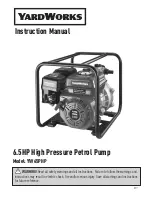
12
12
TRANSPORTING AND LIFTING
IMPORTANT:
Lifting and carrying operations should be carried out by skilled workers,
such as a truck operator, crane operator, etc. If a crane is used to lift the machine, attach the
lifting chain carefully, making sure the machine is well balanced.
Follow these guidelines when lifting with truck or trolley:
•
The lift truck must be able to lift at least 1.5
– 2 times
the machines gross weight.
•
Make sure the machine is balanced. While
transporting, avoid rough or jerky motion, and maintain
a safe clearance zone around the transport area.
•
Use a fork lift with sufficient lifting capacity and forks
that are long enough to reach the complete width of
the machine.
•
Remove the securing bolts that attach the machine to
the pallet.
•
Approaching the machine from the side, lift the machine on the frame taking care that there
are no cables or pipes in the area of the forks.
•
Move the machine to the required position and lower gently to the floor.
•
Level the machine so that all the supporting feet are taking the weight of the machine and no
rocking is taking place.
INSTALLATION
IMPORTANT:
Consider the following when looking for a suitable location to place the machine:
•
Overall weight of the machine.
•
Weight of material being processed.
•
Sizes of material to be processed through the machine.
•
Space needed for auxiliary stands, work tables, or other machinery.
•
Clearance from walls and other obstacles.
•
Maintain an adequate working area around the machine for safety.
•
Have the work area well illuminated with proper lighting.
•
Keep the floor free of oil and make sure it is not slippery.
Summary of Contents for DP-2012F-HD-V3
Page 17: ...15 15...
Page 24: ...22 22 ELECTRICAL SCHEMATIC...
Page 31: ...29 29 STAND TABLE PARTS DIAGRAM...
Page 32: ...30 30 HEADSTOCK PARTS DIAGRAM...
Page 38: ...36 36 NOTES...
Page 39: ...37 37 NOTES...















































